If you love ornamental or indoor plants, check out the different types of Calathea which symbolizes a new beginning. Read on.

What Is Calathea?
Calathea is a genus flowering plant from the family of Marantaceae. These plants are also known as Calatheas or prayer plants. Calatheas have kaleidoscopic and ornamental leaves, and most of them are generally grown as indoor plants. Around 200 species previously designated to Calathea are now under genus Goeppertia. This genus has a variety of species.
Before we introduce you with the Calathea varieties, it is also important to know how to grow these types of plants and what type of soil the Calathea plants suit best. Read further.
How To Take Care of Calathea?
When it comes to growing varieties of Calathea plants, it is an advantage for plant growers to have a little background about the type of soil to use. Calatheas do well in well-drained and fertile soil. You can mix 25% additional peat moss with snared houseplant potting soil to have a rich soil base.
All types of Calathea plants should not be exposed to direct sunlight. Be aware that these are indoor plants and therefore, do best in bright indirect light settings, from partial shade to full shade. Calatheas are also tropical plants, which means they need a warmer indoor temperature, ranging from 60° – 80° degrees Fahrenheit.
When it comes to the watering method, Calathea plants need not be watered heavily. They do best with a soak, dry, and moderate watering. Excess water will not only make the soil soggy, but can result in pests problems like aphids, spider mites, and scale. The moisture can also make the Calathea leaves dry up, curl, and edges turning to brown.
With that being said, make sure to wait until the soil becomes try before watering the plants again. Calathea plants are also sensitive to bromine, chlorine, and fluoride. Therefore, utilizing distilled or rain water is advised.
And even if you have used the fertile soil when planting the Calatheas, it is also recommended to fertilize these tropical plants every two weeks. You can use half-density of dissolved houseplant fertilizer.
Different Types of Calathea
These popular houseplants can also be grown outdoors in a tropical to semi-tropical location. Here are the different types of Calathea plants with eye-catching and unique colored foliage.
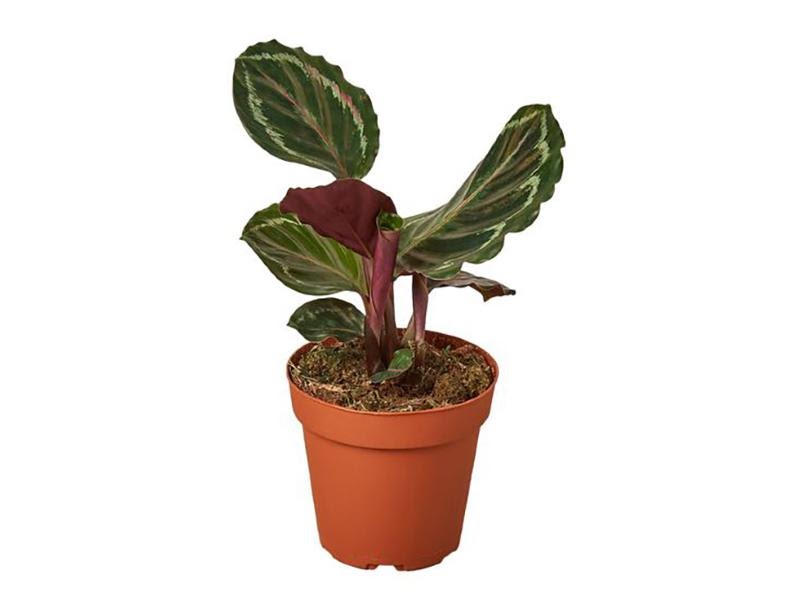
Calathea Roseopicta (Calathea Corona)
Calathea Roseopicta, also called Rose Painted Calathea or Corona Painted Calathea, is a popular type of Calathea with broad and silvery-green leaves. The edge of the leaves have a wide band of dark green, with a distinct reddish-color mid-rib on each leaf. The new leaves of the Calathea Roseopicta curl when they come out and show the purplish red on its undersurfaces.
Calathea Roseopicta can grow up to 20 inches tall and wide. To keep this variety in good shape, plant it in a well-drained, uniformly moist, and rich soil base. Indoor temperature should be between 65°F to 80°F and never put the plant in a cold drafty settings.
For best leaf color and growth, expose Calathea Roseopicta in a bright filtered light. Fertilizing the plant once a month with infirm dissolved houseplant mixture. You also need to flush the soil from time to time to prevent the formation of salt and produce humidity.
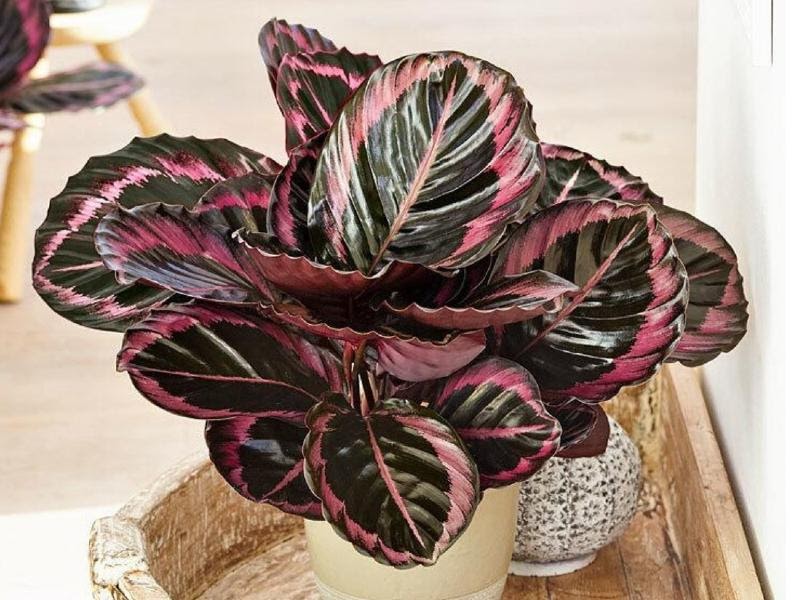
Calathea Roseopicta Dottie
Calathea Roseopicta ‘Dottie’ is a variety reproduced from Calathea Roseopicta. Dottie has a large and glossy foliage, similar to its Corona. It has oval-shaped leaves with a deep greenish-black color. The edge of the leaf is almost fuchsia pink down to the center left margin. Calathea Roseopicta Dottie can also grow up to 20 inches tall and wide. The care requirements of this plant is similar to its mother.
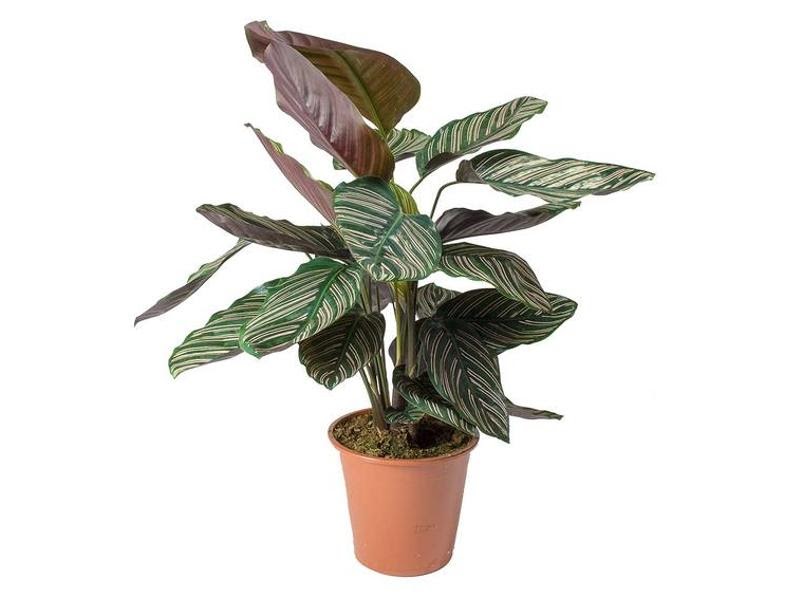
Calathea Ornata Sanderiana
Calathea Sanderiana – Pin-Stripe Calathea, is an air purifying and foliage plant with large dark green and glossy leaves. Each leaf has white fish bone-like stripes with pink overtones and purple underneath.
For the plant to have a finer foliage, expose it to indirect light. Just like most of the Calathea varieties, Calathea Sanderiana’s leaves will fade and lose its markings when exposed to direct sunlight.
For its watering method, never sit Calathea Sanderiana in a very wet soil. The plant should also be located in warm to high temperatures, ranging from 18-23°C. Don’t forget to water the plant and make sure it has enough ventilation.

Calathea Lancifolia
This lovely showy houseplant is also known as the rattlesnake Calathea or rattlesnake plant. It is native to Rio de Janeiro state in Brazil. Its leaves are colored with dark green strokes with a pale background, dark blotches, and purple underneath. Calathea Lancifolia or Calathea insignis can grow up to 18 inches tall.
Calathea Lancifolia can bloom yellow flowers during spring time. This rattlesnake plant should be kept in a rich and well-drained soil during the growing season. Should not be exposed to direct sunlight, but to bright filtered light. Room temperature must be between 65°F and 75°F.
Fertilize the plant every month with a not so strong water-soluble houseplant blend. It is also recommended to occasionally flush the soil to avoid and remove salt formation.
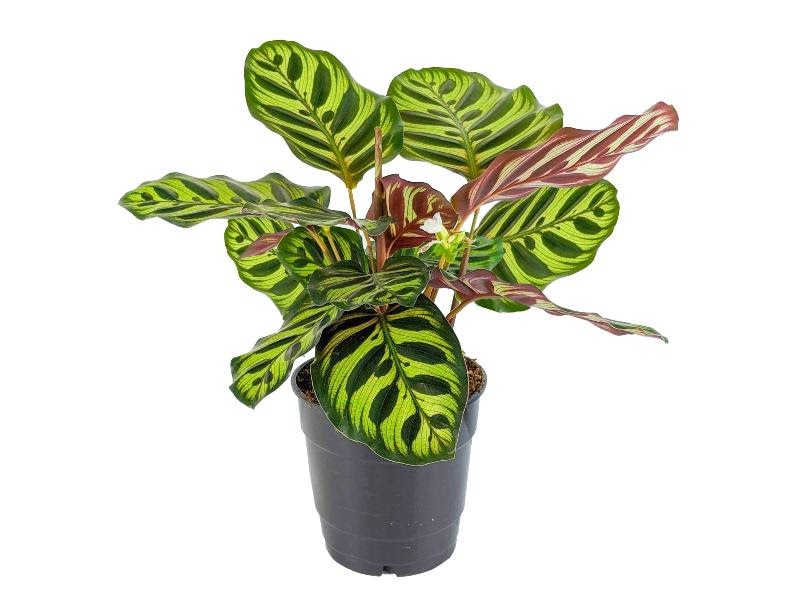
Calathea Makoyana
Calathea Makoyana, commonly known as the Peacock plant or Cathedral Windows, has colorful markings on the egg-shaped foliage. Its leaves are papery thin and colored-purple underneath. It is called the Peacock plant because of the light green and dark green peacock markings bordered with cream feathering. The leaf can grow up to 12 inches long. This houseplant can also bloom during the springtime.
For a healthy Calathea Makoyana plant, grow it in a fertile pot with proper drainage to keep the soil constantly moist. The plant should also be in a location with high humidity and with temperatures between 60°F and 75°F.
Calathea makoyana is salt-sensitive, similar to most Calatheas. It is recommended to feed the plant with half-strength water-soluble houseplant blend and occasionally flush the soil to remove salt formation.
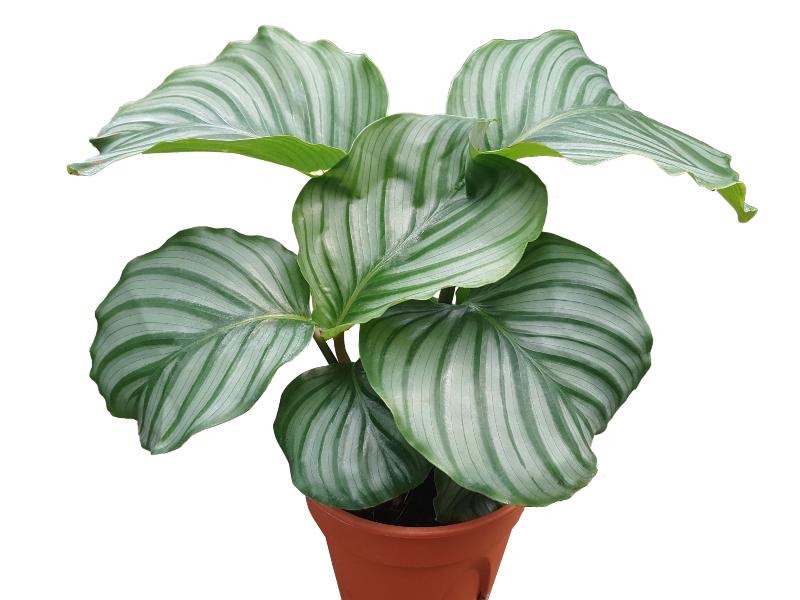
Calathea Orbifolia
Calathea Orbifolia is a prayer plant native to Bolivia. It is one of the largest Calatheas with bold oval leaves that can grow a foot wide and mature plants can grow around 2.5 ft tall and wide. This plant grows better in tropical areas.
Orbifolia must be kept in a warm indoor temperature between 65°F to 80°F. For a healthy and undamaged cultivar, grow the plant in a rich, well-drained, and uniformly moist soil. To prevent leaf curling and keep the foliage to look good, maintain high humidity.
When the plant is still actively growing, it is recommended to fertilize it monthly using a balanced fertilizer. Flushing the soil occasionally is also needed to remove salt buildup.For best growth and leaf color, expose the plant to medium, filtered light.

Calathea Musaica
Calathea Musaica, also known as Network, is a wonderful houseplant with small leaves that feature attractive streaked. This variety of Calathea requires easier care compared to other cultivars.
Calathea Musaica needs bright, indirect light, 50-80 percent humidity, and should be planted in a well-drained soil. For bring out the mesmerizing patterning, avoid drafts, keep the indoor temperatures between 65-85°F, and fertilize the plant once a month during springtime and summer.

Calathea Rufibarba
Calathea Rufibarba, commonly known as Furry Feather Calathea, got its name from its fuzzy, fur-like underleaf texture. It is a flowering Calathea plant native to Northeastern Brazil.
Calathea Rufibarba does well in a warm indoor environment with temperatures ranging from 65°F and 80°F. The plant should also be exposed to bright filtered or indirect sunlight to prevent leaf discoloration. For a healthy Calathea Rufibarba plant, grow it in well-drained but consistently moist soil, especially during its active growth. For best growth, keep the plant in high humidity.
Calathea Rufibarba must also be fertilized once a month using a mild blend of dissolved houseplant formula. To remove salt formation, flush the soil occasionally.
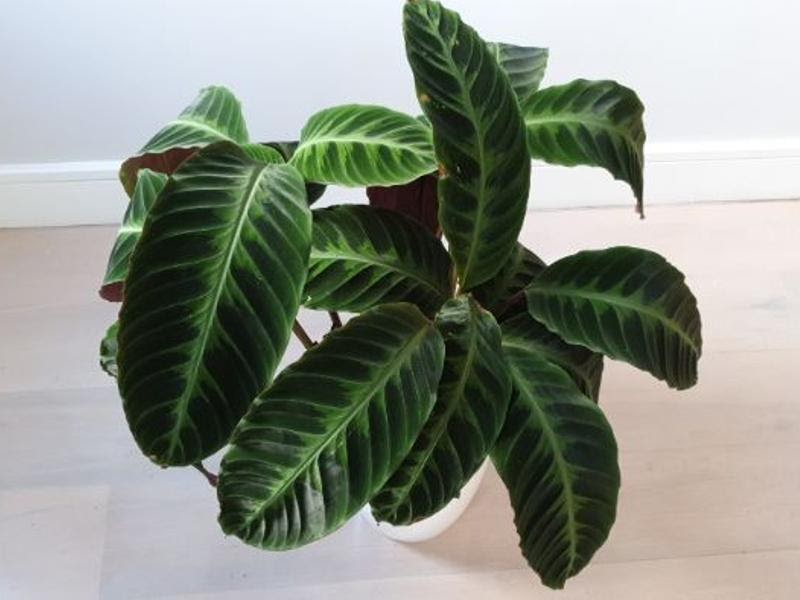
Calathea Warscewiczii
Calathea Warscewiczii is an evergreen Calathea species native to Costa Rica and Nicaragua. It is also known as Calathea Jungle Velvet. It has patterned lanceolate leaves with white cone-like spike that fades from dark green foliage to yellow or pink.
A healthy Calathea Warscewiczii has dark green leaves banded with distinct bright green and dark purple undersides. Each leaf can grow up to 12 inches tall while the mature plant can reach up to 3 feet tall.
Same with other Calathea species, Warscewiczii should be grown in a well-drained, not soggy soil, and rich soil. It must be kept in indoor temperatures between 65°F to 80°F, and high humidity should be maintained.
This is also among the Calathea varieties that should not be kept in cold and drafty settings. It is preferable for the plant to be exposed to bright filtered light or indirect sunlight. Exposure to too much bright light will make its velvety leaves scorched and will turn to lighter green or pale green.
It is also ideal to fertilize Warscewiczii once a month using a mild water-soluble houseplant blend especially during growing season. Flushing the soil every other month to prevent salt formation is also recommended.
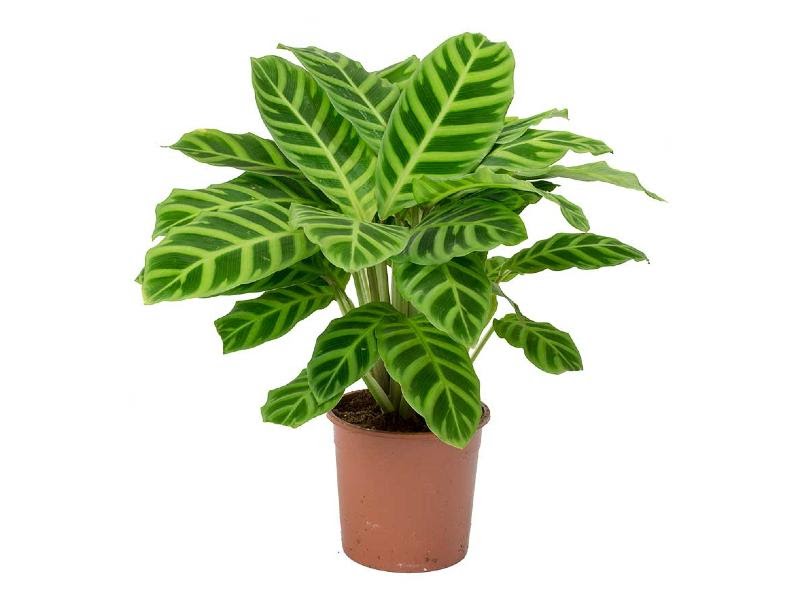
Calathea Zebrina
Calathea Zebrina, also known as the zebra plant, is one of the stunning foliage plants that show large ovate leaves that can grow up to 1 meter tall from its long green stems. Calathea Zebrina is native to Mexico, and among the Calathea varieties that do not demand extra care.
As long as this lovely plant is kept in a bright indirect sunlight and enough humidity, it should grow healthy light green leaves, white stripes, and deep purple undersides. A monthly fertilization using half-strength dissolved houseplant blend and occasional soil flushing is also needed to keep the plant healthy.

Calathea Crocata
Calathea Crocata, also known as Eternal Flame Plant, is among the popular Calathea species. It is called the eternal flame plant because of its striking bright orange or yellow flowers. Calathea Crocata is native to tropical America and Brazil. However, because of environmental damage, this specie now becomes endangered
Its flowers fade after 2-3 months and the mature plants can grow up to 2 feet tall and wide. This Calathea cultivar does well in a warm and humid environment. It should also be situated indoors with temperatures from 65°F to 80°F.
Since Crocata can’t tolerate extreme heat from direct sunlight, it is best to keep it indoors with bright to medium indirect sunlight exposure.